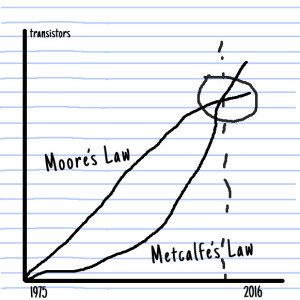Moore, Metcalfe and Me
by Mike Fahrion

Over the years I’ve made many presentations in which I discussed the technology-enabled collision between Moore’s Law and Metcalfe’s Law. Moore famously predicted that the number of transistors that could be placed in a dense integrated circuit would continue to double every 18 – 24 months for the foreseeable future, making computers ever more powerful and making it possible to place intelligence in smaller and smaller devices. Metcalfe stated that the value of a network is proportional to the square of the number of connected users of the system. (I think we’d all agree that the development of the global Internet has proven his point very nicely.) I said that Moore and Metcalfe’s laws would interact to produce an incredible acceleration of innovation — we’d be engaging warp drive.
Moore and Metcalfe were both right, and it’s fun to be able to say that I was, too. We are now living in a world where technologies are advancing so quickly that even the most change-resistant industries are taking notice and getting caught up in the movement. Whether it’s adding new capabilities that were only a dream a few short years ago, or making existing capabilities more accessible by making them smaller, less expensive and less power hungry, we’re seeing some real game changers. Here are a few examples:
Ever-increasing Bandwidth
We’re transitioning into a data-driven economy. Build a bigger data pipe and applications will automatically spring up that can use that bandwidth to deliver real value. Not so long ago we were excited when we could upgrade our modems to 56 kbps. We’ve improved that by 4-5 orders of magnitude in just 20 years. The ability to binge watch Madmen is only a tiny part of the story. Today’s high bandwidth is enabling incredible new capabilities in every industry.
Lower Power
The need to charge my phone every day is a minor annoyance compared to the amazing amount of computing power and communications that such a small device can now deliver in exchange. In the world of connected things, some of the same technologies that reside in my phone are working wonders in industry as well. Among other things, they now enable wireless sensors that can be deployed in rugged and industrial settings — with battery lives approaching a decade. This opens the door to real energy harvesting applications as well, although that’s a topic for another day.
IT Technology Infiltration
This can be a volatile topic in certain quarters, but the inevitable truth is that we are increasingly living in an Internet Protocol (IP) world. There have certainly been some industries that have tried to hold out and ignore this over the last decade or two. But the writing is on the wall, and that’s not a bad thing. IP is enabling a marriage between IT and Operations Technologies (OT). It may be a rocky relationship at first, but the end result will be interoperability, scalability, frictionless deployments of new applications, and the ability to use and reuse existing data, existing sensors and existing networks across many applications. (There will, of course, be numerous security panics to keep things interesting.) Companies with strong technology vision have already begun to eat their competitors’ lunches, and that will ultimately drag even the most obstinate players on board.
Augmented Reality and Wearables
Most of us are quite content with our computers today, but we’ll soon realize that mimicking the “typewriter” user experience is not always going to be the best way to interface with technology. Wearable technology and augmented reality will enable computers to be extensions of ourselves, rather than tools that create an artificial barrier between the user and the task at hand – whether that’s research, communications or entertainment.
Smarter Everything
“Things” will keep getting smarter. They will be self-configuring. They will minimize the time and skill required to turn them into functional devices. One new example from the B+B development center is our Swarm 351 Modbus Gateway. We created it because so many people have millions of dollars invested in older Modbus systems that don’t support IP protocols or IT-type technologies. Even if they’d like to take advantage of the benefits that the IT world can provide, they often feel trapped by the financial constraints.
The Swarm 351 Modbus Gateway solves that problem. Swarm 351 will listen in on existing Modbus networks without affecting their operations in any way. It learns about the devices communicating on that network. It collects the cryptic Modbus data, then enriches and enhances it by transforming it to MQTT and JSON for consumption by upstream applications, where its descriptive JSON data is easily integrated into the applications at the IT and Enterprise layer. Swarm 351 also filters the Modbus data, publishing only the data that has value. A temperature parameter that has remained within pre-determined parameters, for example, would only be sent across the network if a it’s been configured as being of interest. This eliminates unnecessary network traffic. Swarm 351 is an excellent example of the new types of smart devices that are making it easy to get meaningful information from existing industrial systems without disrupting processes or programming that are already in place.
Moore’s Law predicted that while capabilities would continually increase, the cost of those capabilities would continually drop. Metcalf’s Law shows us that expanding the network increases its value, as clearly happens when a device like Swarm 351 suddenly network-enables a legacy Modbus system that would otherwise have remained siloed. Fahrion’s Law says that the interaction of Moore and Metcalfe’s Laws is going to be a fun and fabulous ride – and that we’re only getting started.
— Mike
Recommended Posts

Co-Creation, Paving the Way to a More Connected Future
November 27, 2018

The Benefits of a ‘Do It For Me’ Mentality in the IIoT
October 5, 2018

Why You Need to ‘Mind the Gap’ in Manufacturing Technology
August 31, 2018
